Sociology Essay: Ethical Clothing and Global Challenges, UNCC300
VerifiedAdded on 2022/11/19
|6
|1520
|433
Essay
AI Summary
This essay delves into the multifaceted challenges posed by the ethical clothing industry, examining its impact on the common good both in the Australian context and on a global scale. It critiques how the industry's practices, including exploitation, environmental concerns, and unsustainable production, undermine societal well-being and proposes actionable solutions. The essay emphasizes the importance of understanding the relationship between ethical clothing and the principles of Human Dignity and the Common Good, advocating for changes in consumer behavior, industry practices, and governmental policies. It highlights the role of advocacy and community engagement in fostering a more just and sustainable fashion industry, referencing relevant research and examples to support its arguments. The essay suggests mainstreaming ethical clothing, promoting awareness, and encouraging investment in sustainable clothes, thereby contributing to a more responsible and ethical approach to the fashion industry and its impact on society.
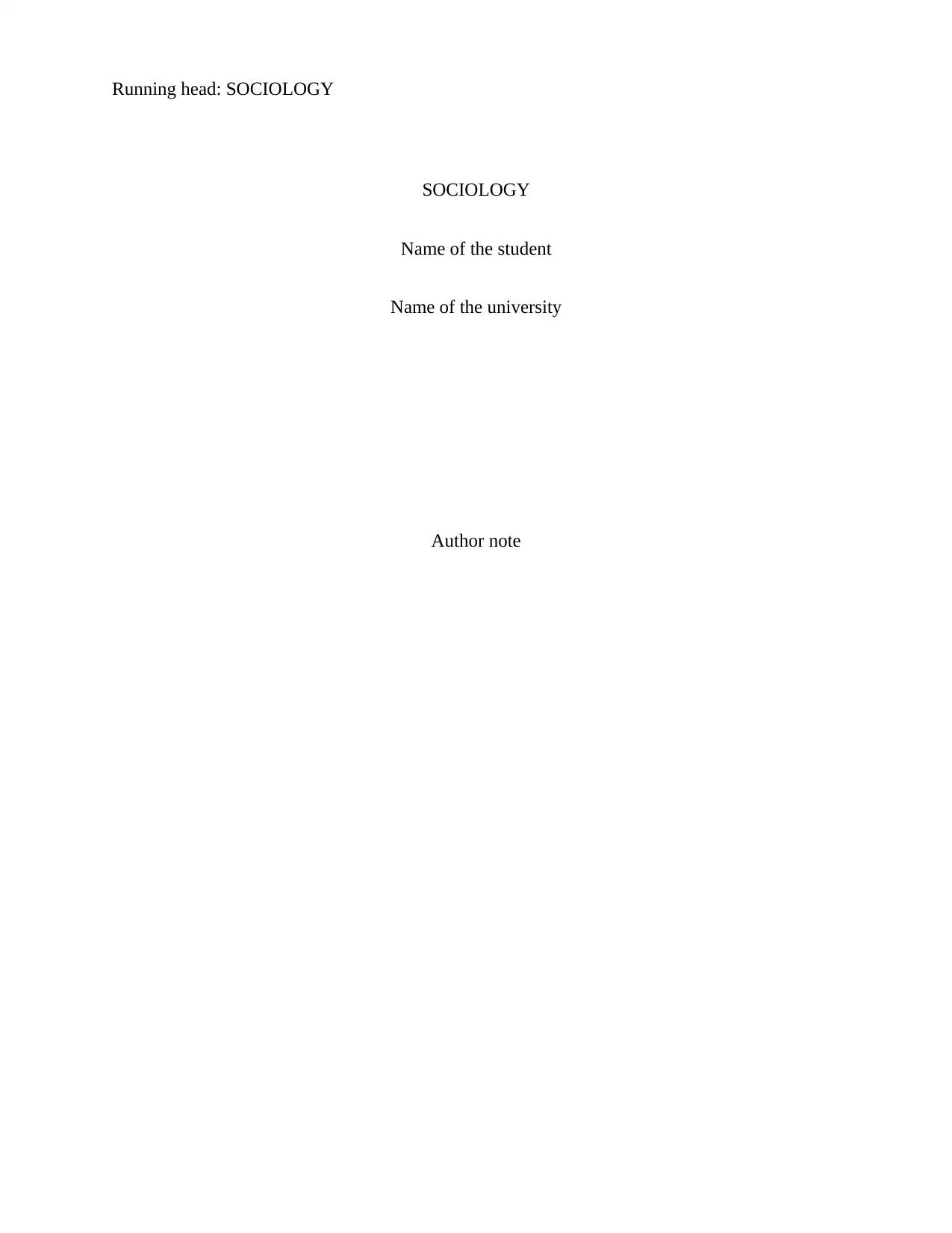
Running head: SOCIOLOGY
SOCIOLOGY
Name of the student
Name of the university
Author note
SOCIOLOGY
Name of the student
Name of the university
Author note
Paraphrase This Document
Need a fresh take? Get an instant paraphrase of this document with our AI Paraphraser
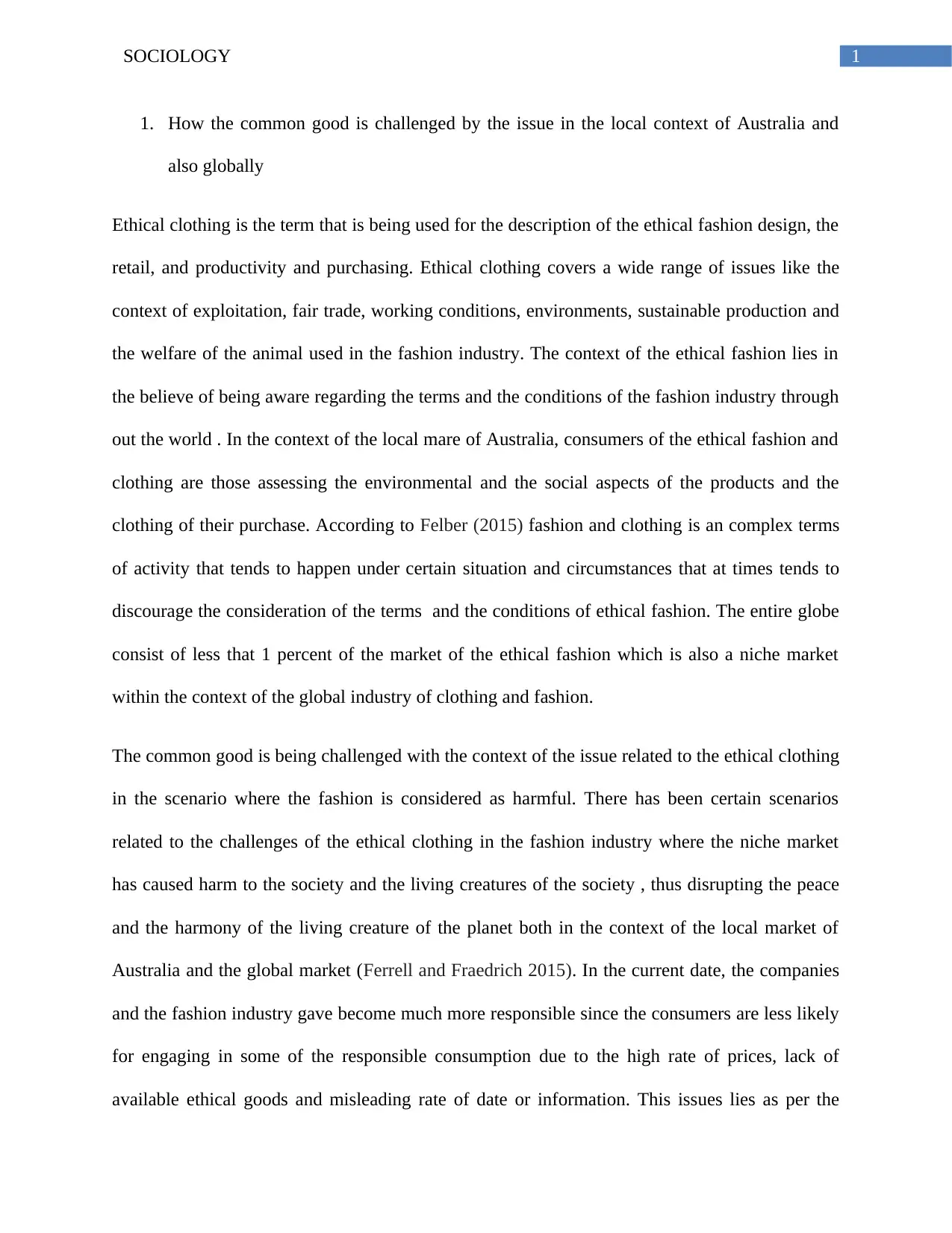
SOCIOLOGY 1
1. How the common good is challenged by the issue in the local context of Australia and
also globally
Ethical clothing is the term that is being used for the description of the ethical fashion design, the
retail, and productivity and purchasing. Ethical clothing covers a wide range of issues like the
context of exploitation, fair trade, working conditions, environments, sustainable production and
the welfare of the animal used in the fashion industry. The context of the ethical fashion lies in
the believe of being aware regarding the terms and the conditions of the fashion industry through
out the world . In the context of the local mare of Australia, consumers of the ethical fashion and
clothing are those assessing the environmental and the social aspects of the products and the
clothing of their purchase. According to Felber (2015) fashion and clothing is an complex terms
of activity that tends to happen under certain situation and circumstances that at times tends to
discourage the consideration of the terms and the conditions of ethical fashion. The entire globe
consist of less that 1 percent of the market of the ethical fashion which is also a niche market
within the context of the global industry of clothing and fashion.
The common good is being challenged with the context of the issue related to the ethical clothing
in the scenario where the fashion is considered as harmful. There has been certain scenarios
related to the challenges of the ethical clothing in the fashion industry where the niche market
has caused harm to the society and the living creatures of the society , thus disrupting the peace
and the harmony of the living creature of the planet both in the context of the local market of
Australia and the global market (Ferrell and Fraedrich 2015). In the current date, the companies
and the fashion industry gave become much more responsible since the consumers are less likely
for engaging in some of the responsible consumption due to the high rate of prices, lack of
available ethical goods and misleading rate of date or information. This issues lies as per the
1. How the common good is challenged by the issue in the local context of Australia and
also globally
Ethical clothing is the term that is being used for the description of the ethical fashion design, the
retail, and productivity and purchasing. Ethical clothing covers a wide range of issues like the
context of exploitation, fair trade, working conditions, environments, sustainable production and
the welfare of the animal used in the fashion industry. The context of the ethical fashion lies in
the believe of being aware regarding the terms and the conditions of the fashion industry through
out the world . In the context of the local mare of Australia, consumers of the ethical fashion and
clothing are those assessing the environmental and the social aspects of the products and the
clothing of their purchase. According to Felber (2015) fashion and clothing is an complex terms
of activity that tends to happen under certain situation and circumstances that at times tends to
discourage the consideration of the terms and the conditions of ethical fashion. The entire globe
consist of less that 1 percent of the market of the ethical fashion which is also a niche market
within the context of the global industry of clothing and fashion.
The common good is being challenged with the context of the issue related to the ethical clothing
in the scenario where the fashion is considered as harmful. There has been certain scenarios
related to the challenges of the ethical clothing in the fashion industry where the niche market
has caused harm to the society and the living creatures of the society , thus disrupting the peace
and the harmony of the living creature of the planet both in the context of the local market of
Australia and the global market (Ferrell and Fraedrich 2015). In the current date, the companies
and the fashion industry gave become much more responsible since the consumers are less likely
for engaging in some of the responsible consumption due to the high rate of prices, lack of
available ethical goods and misleading rate of date or information. This issues lies as per the
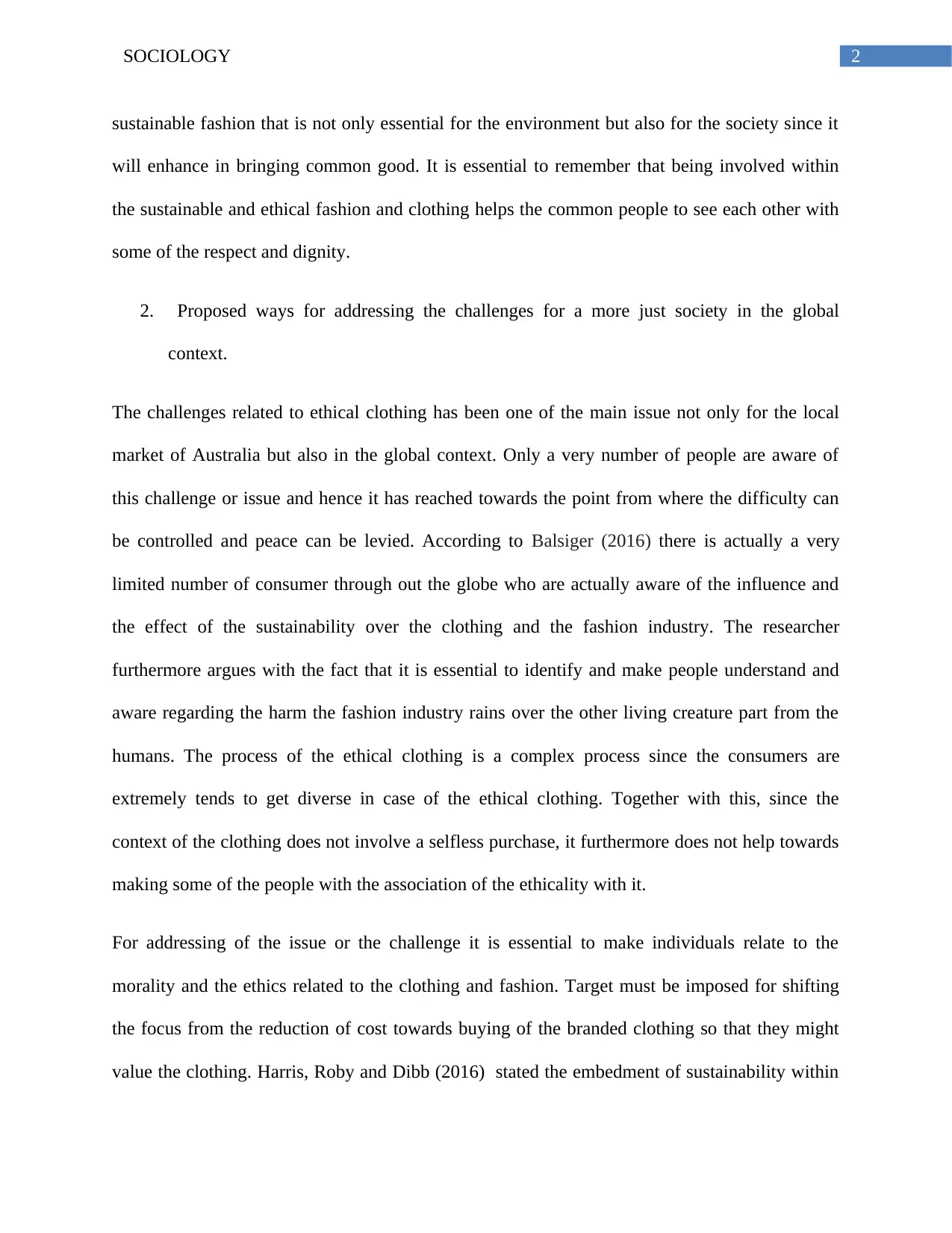
2SOCIOLOGY
sustainable fashion that is not only essential for the environment but also for the society since it
will enhance in bringing common good. It is essential to remember that being involved within
the sustainable and ethical fashion and clothing helps the common people to see each other with
some of the respect and dignity.
2. Proposed ways for addressing the challenges for a more just society in the global
context.
The challenges related to ethical clothing has been one of the main issue not only for the local
market of Australia but also in the global context. Only a very number of people are aware of
this challenge or issue and hence it has reached towards the point from where the difficulty can
be controlled and peace can be levied. According to Balsiger (2016) there is actually a very
limited number of consumer through out the globe who are actually aware of the influence and
the effect of the sustainability over the clothing and the fashion industry. The researcher
furthermore argues with the fact that it is essential to identify and make people understand and
aware regarding the harm the fashion industry rains over the other living creature part from the
humans. The process of the ethical clothing is a complex process since the consumers are
extremely tends to get diverse in case of the ethical clothing. Together with this, since the
context of the clothing does not involve a selfless purchase, it furthermore does not help towards
making some of the people with the association of the ethicality with it.
For addressing of the issue or the challenge it is essential to make individuals relate to the
morality and the ethics related to the clothing and fashion. Target must be imposed for shifting
the focus from the reduction of cost towards buying of the branded clothing so that they might
value the clothing. Harris, Roby and Dibb (2016) stated the embedment of sustainability within
sustainable fashion that is not only essential for the environment but also for the society since it
will enhance in bringing common good. It is essential to remember that being involved within
the sustainable and ethical fashion and clothing helps the common people to see each other with
some of the respect and dignity.
2. Proposed ways for addressing the challenges for a more just society in the global
context.
The challenges related to ethical clothing has been one of the main issue not only for the local
market of Australia but also in the global context. Only a very number of people are aware of
this challenge or issue and hence it has reached towards the point from where the difficulty can
be controlled and peace can be levied. According to Balsiger (2016) there is actually a very
limited number of consumer through out the globe who are actually aware of the influence and
the effect of the sustainability over the clothing and the fashion industry. The researcher
furthermore argues with the fact that it is essential to identify and make people understand and
aware regarding the harm the fashion industry rains over the other living creature part from the
humans. The process of the ethical clothing is a complex process since the consumers are
extremely tends to get diverse in case of the ethical clothing. Together with this, since the
context of the clothing does not involve a selfless purchase, it furthermore does not help towards
making some of the people with the association of the ethicality with it.
For addressing of the issue or the challenge it is essential to make individuals relate to the
morality and the ethics related to the clothing and fashion. Target must be imposed for shifting
the focus from the reduction of cost towards buying of the branded clothing so that they might
value the clothing. Harris, Roby and Dibb (2016) stated the embedment of sustainability within
⊘ This is a preview!⊘
Do you want full access?
Subscribe today to unlock all pages.

Trusted by 1+ million students worldwide
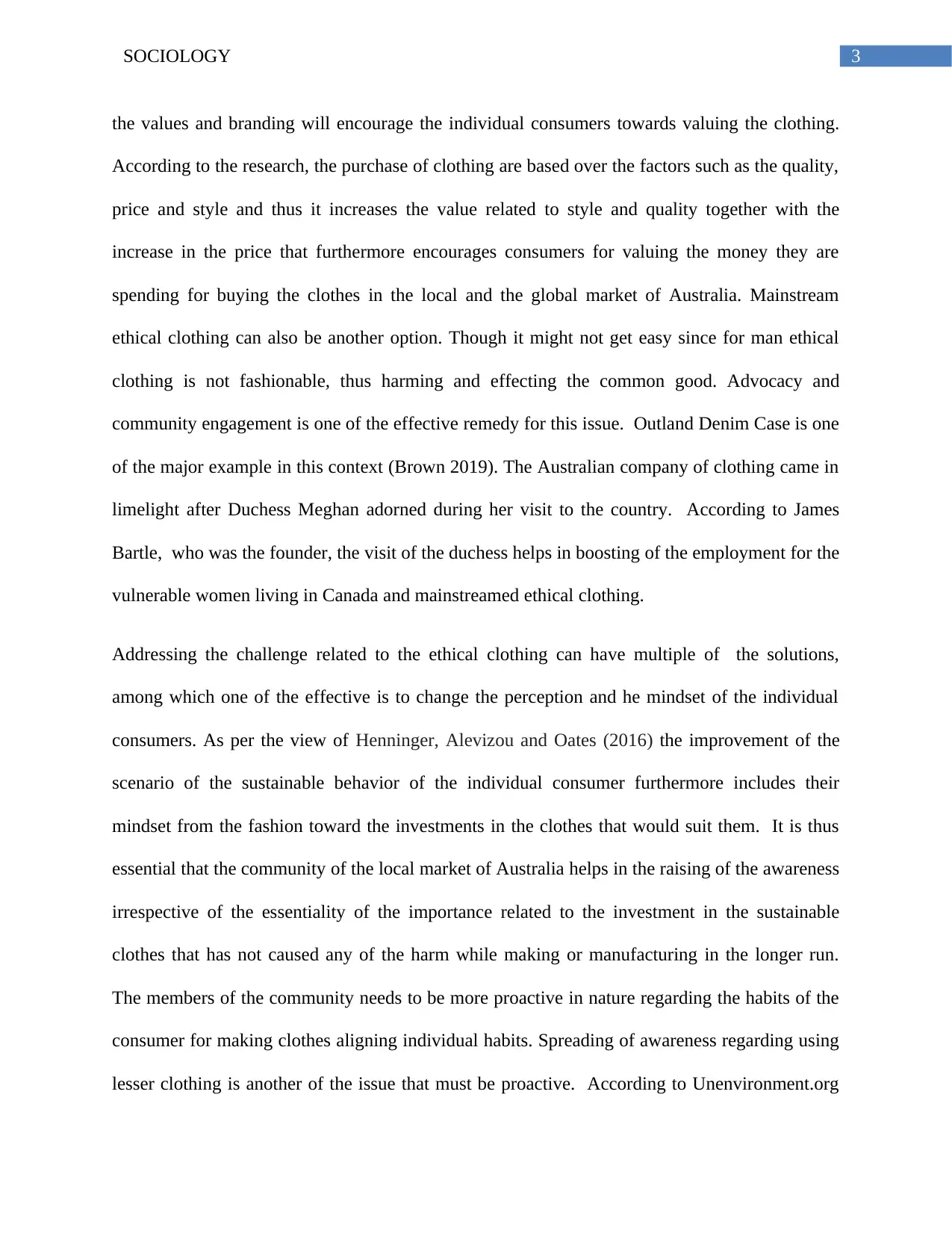
3SOCIOLOGY
the values and branding will encourage the individual consumers towards valuing the clothing.
According to the research, the purchase of clothing are based over the factors such as the quality,
price and style and thus it increases the value related to style and quality together with the
increase in the price that furthermore encourages consumers for valuing the money they are
spending for buying the clothes in the local and the global market of Australia. Mainstream
ethical clothing can also be another option. Though it might not get easy since for man ethical
clothing is not fashionable, thus harming and effecting the common good. Advocacy and
community engagement is one of the effective remedy for this issue. Outland Denim Case is one
of the major example in this context (Brown 2019). The Australian company of clothing came in
limelight after Duchess Meghan adorned during her visit to the country. According to James
Bartle, who was the founder, the visit of the duchess helps in boosting of the employment for the
vulnerable women living in Canada and mainstreamed ethical clothing.
Addressing the challenge related to the ethical clothing can have multiple of the solutions,
among which one of the effective is to change the perception and he mindset of the individual
consumers. As per the view of Henninger, Alevizou and Oates (2016) the improvement of the
scenario of the sustainable behavior of the individual consumer furthermore includes their
mindset from the fashion toward the investments in the clothes that would suit them. It is thus
essential that the community of the local market of Australia helps in the raising of the awareness
irrespective of the essentiality of the importance related to the investment in the sustainable
clothes that has not caused any of the harm while making or manufacturing in the longer run.
The members of the community needs to be more proactive in nature regarding the habits of the
consumer for making clothes aligning individual habits. Spreading of awareness regarding using
lesser clothing is another of the issue that must be proactive. According to Unenvironment.org
the values and branding will encourage the individual consumers towards valuing the clothing.
According to the research, the purchase of clothing are based over the factors such as the quality,
price and style and thus it increases the value related to style and quality together with the
increase in the price that furthermore encourages consumers for valuing the money they are
spending for buying the clothes in the local and the global market of Australia. Mainstream
ethical clothing can also be another option. Though it might not get easy since for man ethical
clothing is not fashionable, thus harming and effecting the common good. Advocacy and
community engagement is one of the effective remedy for this issue. Outland Denim Case is one
of the major example in this context (Brown 2019). The Australian company of clothing came in
limelight after Duchess Meghan adorned during her visit to the country. According to James
Bartle, who was the founder, the visit of the duchess helps in boosting of the employment for the
vulnerable women living in Canada and mainstreamed ethical clothing.
Addressing the challenge related to the ethical clothing can have multiple of the solutions,
among which one of the effective is to change the perception and he mindset of the individual
consumers. As per the view of Henninger, Alevizou and Oates (2016) the improvement of the
scenario of the sustainable behavior of the individual consumer furthermore includes their
mindset from the fashion toward the investments in the clothes that would suit them. It is thus
essential that the community of the local market of Australia helps in the raising of the awareness
irrespective of the essentiality of the importance related to the investment in the sustainable
clothes that has not caused any of the harm while making or manufacturing in the longer run.
The members of the community needs to be more proactive in nature regarding the habits of the
consumer for making clothes aligning individual habits. Spreading of awareness regarding using
lesser clothing is another of the issue that must be proactive. According to Unenvironment.org
Paraphrase This Document
Need a fresh take? Get an instant paraphrase of this document with our AI Paraphraser
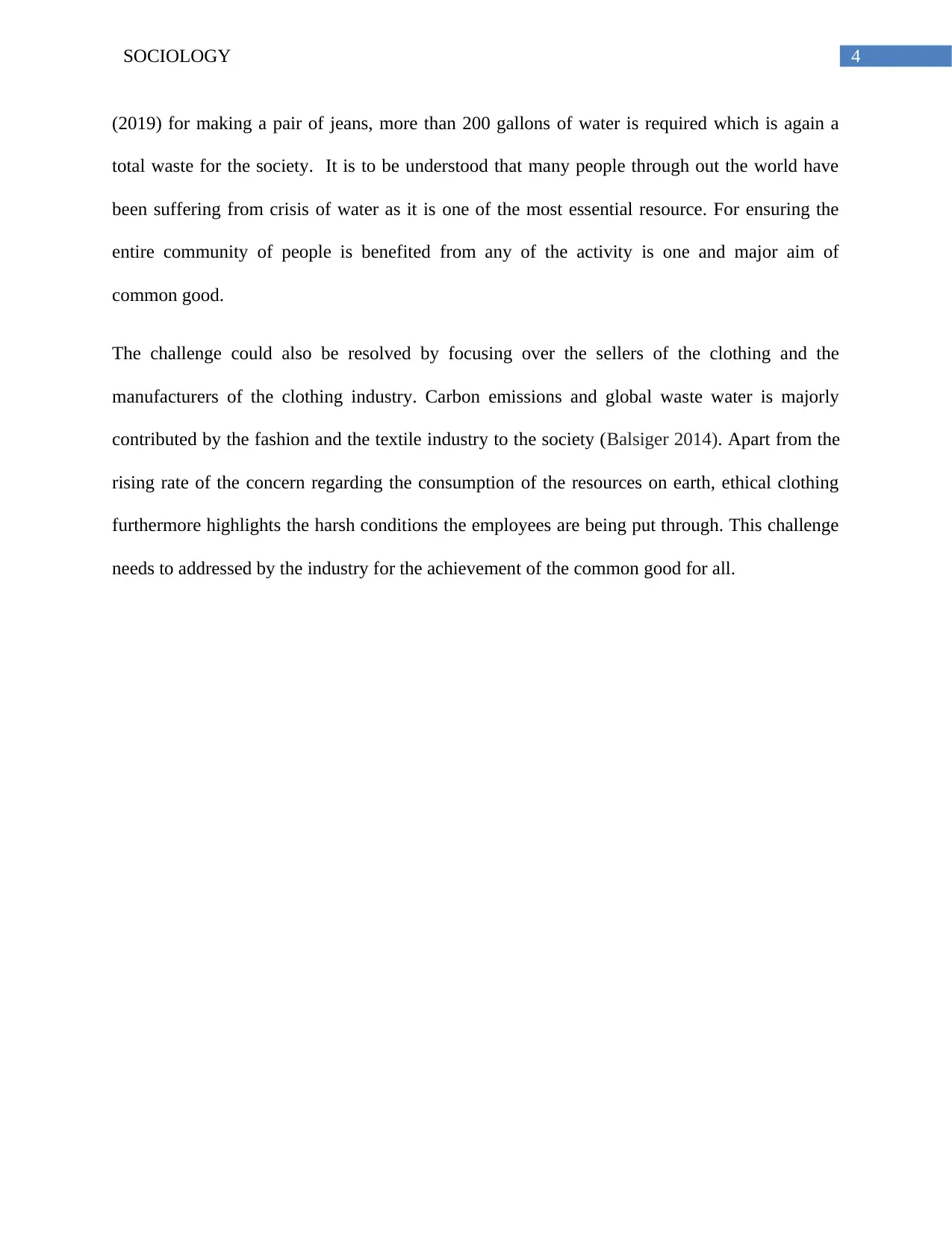
4SOCIOLOGY
(2019) for making a pair of jeans, more than 200 gallons of water is required which is again a
total waste for the society. It is to be understood that many people through out the world have
been suffering from crisis of water as it is one of the most essential resource. For ensuring the
entire community of people is benefited from any of the activity is one and major aim of
common good.
The challenge could also be resolved by focusing over the sellers of the clothing and the
manufacturers of the clothing industry. Carbon emissions and global waste water is majorly
contributed by the fashion and the textile industry to the society (Balsiger 2014). Apart from the
rising rate of the concern regarding the consumption of the resources on earth, ethical clothing
furthermore highlights the harsh conditions the employees are being put through. This challenge
needs to addressed by the industry for the achievement of the common good for all.
(2019) for making a pair of jeans, more than 200 gallons of water is required which is again a
total waste for the society. It is to be understood that many people through out the world have
been suffering from crisis of water as it is one of the most essential resource. For ensuring the
entire community of people is benefited from any of the activity is one and major aim of
common good.
The challenge could also be resolved by focusing over the sellers of the clothing and the
manufacturers of the clothing industry. Carbon emissions and global waste water is majorly
contributed by the fashion and the textile industry to the society (Balsiger 2014). Apart from the
rising rate of the concern regarding the consumption of the resources on earth, ethical clothing
furthermore highlights the harsh conditions the employees are being put through. This challenge
needs to addressed by the industry for the achievement of the common good for all.
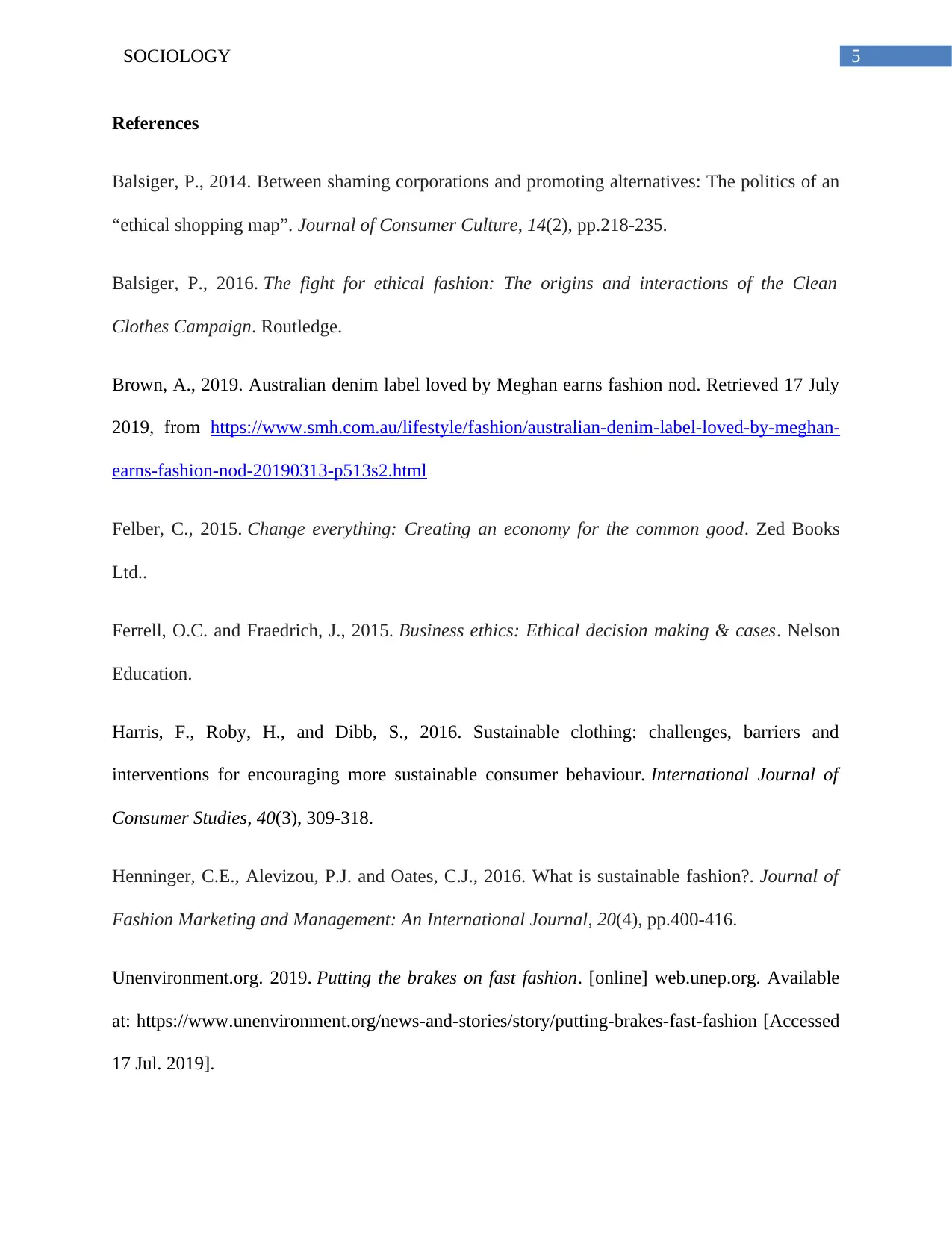
5SOCIOLOGY
References
Balsiger, P., 2014. Between shaming corporations and promoting alternatives: The politics of an
“ethical shopping map”. Journal of Consumer Culture, 14(2), pp.218-235.
Balsiger, P., 2016. The fight for ethical fashion: The origins and interactions of the Clean
Clothes Campaign. Routledge.
Brown, A., 2019. Australian denim label loved by Meghan earns fashion nod. Retrieved 17 July
2019, from https://www.smh.com.au/lifestyle/fashion/australian-denim-label-loved-by-meghan-
earns-fashion-nod-20190313-p513s2.html
Felber, C., 2015. Change everything: Creating an economy for the common good. Zed Books
Ltd..
Ferrell, O.C. and Fraedrich, J., 2015. Business ethics: Ethical decision making & cases. Nelson
Education.
Harris, F., Roby, H., and Dibb, S., 2016. Sustainable clothing: challenges, barriers and
interventions for encouraging more sustainable consumer behaviour. International Journal of
Consumer Studies, 40(3), 309-318.
Henninger, C.E., Alevizou, P.J. and Oates, C.J., 2016. What is sustainable fashion?. Journal of
Fashion Marketing and Management: An International Journal, 20(4), pp.400-416.
Unenvironment.org. 2019. Putting the brakes on fast fashion. [online] web.unep.org. Available
at: https://www.unenvironment.org/news-and-stories/story/putting-brakes-fast-fashion [Accessed
17 Jul. 2019].
References
Balsiger, P., 2014. Between shaming corporations and promoting alternatives: The politics of an
“ethical shopping map”. Journal of Consumer Culture, 14(2), pp.218-235.
Balsiger, P., 2016. The fight for ethical fashion: The origins and interactions of the Clean
Clothes Campaign. Routledge.
Brown, A., 2019. Australian denim label loved by Meghan earns fashion nod. Retrieved 17 July
2019, from https://www.smh.com.au/lifestyle/fashion/australian-denim-label-loved-by-meghan-
earns-fashion-nod-20190313-p513s2.html
Felber, C., 2015. Change everything: Creating an economy for the common good. Zed Books
Ltd..
Ferrell, O.C. and Fraedrich, J., 2015. Business ethics: Ethical decision making & cases. Nelson
Education.
Harris, F., Roby, H., and Dibb, S., 2016. Sustainable clothing: challenges, barriers and
interventions for encouraging more sustainable consumer behaviour. International Journal of
Consumer Studies, 40(3), 309-318.
Henninger, C.E., Alevizou, P.J. and Oates, C.J., 2016. What is sustainable fashion?. Journal of
Fashion Marketing and Management: An International Journal, 20(4), pp.400-416.
Unenvironment.org. 2019. Putting the brakes on fast fashion. [online] web.unep.org. Available
at: https://www.unenvironment.org/news-and-stories/story/putting-brakes-fast-fashion [Accessed
17 Jul. 2019].
⊘ This is a preview!⊘
Do you want full access?
Subscribe today to unlock all pages.

Trusted by 1+ million students worldwide
1 out of 6
Related Documents
Your All-in-One AI-Powered Toolkit for Academic Success.
+13062052269
info@desklib.com
Available 24*7 on WhatsApp / Email
![[object Object]](/_next/static/media/star-bottom.7253800d.svg)
Unlock your academic potential
Copyright © 2020–2025 A2Z Services. All Rights Reserved. Developed and managed by ZUCOL.





